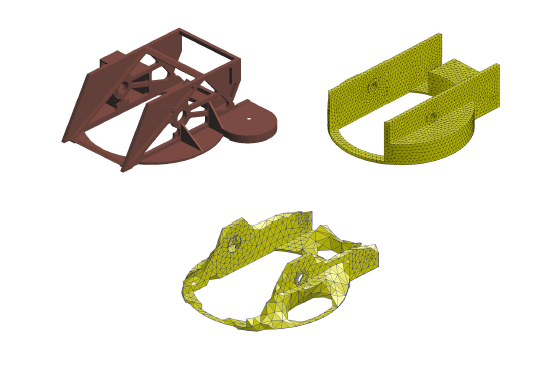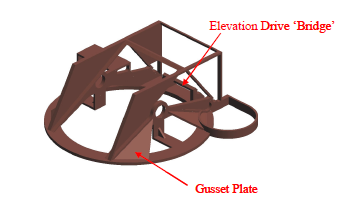Non-Line-of-Sight Cannon (NLOS-C) Turret Saddle was topology optimized by BAE (link). Maybe I am being a bit too negative nowadays but it is hard to see decently optimized structures. This one is not different too. Lets continue with pictures from the article.
The picture above depicts the original saddle, the design space and the resulting optimized topology.
This structure above is the revised version of the turret saddle based on the optimization. It is hard to see the connection between the optimization and this.
 And finally this one is the final structure obtained after size and Topometry optimization. As you can see there is almost no connection between the steps. In the first step they topology optimized the structure, but the resulting structure was not manufacturable by welding of profiles and sheet metal, so it seems they decided to ignore it and design another structure loosely based on it. Instead they coud have changed the parameters of the optimization process and tried again. Or they could have used manufacturing constraints. It is almost always possible to obtain a truss structure from topology optimization by using the right parameters, which can be welded from profiles. The later stages are out of scope of our blog, but I cannot see the connection between inputs and outputs. As a result the weight gain was 7.8%, which is low by topology optimization standards.
And finally this one is the final structure obtained after size and Topometry optimization. As you can see there is almost no connection between the steps. In the first step they topology optimized the structure, but the resulting structure was not manufacturable by welding of profiles and sheet metal, so it seems they decided to ignore it and design another structure loosely based on it. Instead they coud have changed the parameters of the optimization process and tried again. Or they could have used manufacturing constraints. It is almost always possible to obtain a truss structure from topology optimization by using the right parameters, which can be welded from profiles. The later stages are out of scope of our blog, but I cannot see the connection between inputs and outputs. As a result the weight gain was 7.8%, which is low by topology optimization standards.
Maybe we shall start some courses on practical applications/interpretations of topology optimization.


